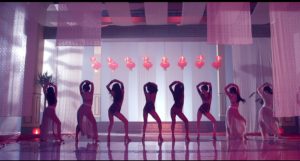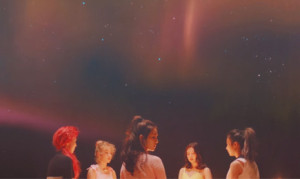 The season has come again for us to plunge through a seemingly insurmountable ocean of releases and emerge with our End-of-Year Review. Following the discussion on debuts, we now move on to MVs. Unlike last year’s review, this round our writers found themselves with three completely different lists. Gaya, Karen, and Qing weigh in with their choices.
The season has come again for us to plunge through a seemingly insurmountable ocean of releases and emerge with our End-of-Year Review. Following the discussion on debuts, we now move on to MVs. Unlike last year’s review, this round our writers found themselves with three completely different lists. Gaya, Karen, and Qing weigh in with their choices.
| Gaya | Karen | Qing | |
| 1 | Sistar – “I Like That” | Mino – “Body” | Sistar ft. Giorgio Moroder – “One More Day” |
| 2 | Baek A-yeon – “So So” | Heize – “And July” | BTS – “Blood Sweat & Tears” |
| 3 | Rainbow – “Whoo” | Sejeong – “Flower Path” | Red Velvet – “One of These Nights” |
| 4 | JYP – “Still Alive” | Pentagon – “Can You Feel It” | Astro – “Breathless” |
| 5 | Lovelyz – “Destiny “ | FT Island – “Take Me Now” | Shin Yong Jae, Luna – “It’s You” |
Gaya: I love how different our lists are!
Qing: I shouldn’t be surprised, given that the choices on the mid-year review already differed significantly. What factors did you consider while making this list? How big of a role does personal preference play?
Gaya: The fact that our lists are all so different is, in my eyes, a reflection of this year’s output: a lot of good stuff, but not a lot that was must-see. I mean, we all saw a lot of the same videos because of the acts they featured, but there weren’t a lot of MVs that were highlighted for their content alone.
 My main criterion was the message of each MV: what was it trying to say, how? There have been a lot of MVs focused on conveying some story or other, so I decided to approach this year’s list from that angle. This meant that I also had to look at an extra criterion: universality. How accessible is the MV’s message to the average viewer? It is a mix of these criteria, as well as aesthetic value, that inform my list.
My main criterion was the message of each MV: what was it trying to say, how? There have been a lot of MVs focused on conveying some story or other, so I decided to approach this year’s list from that angle. This meant that I also had to look at an extra criterion: universality. How accessible is the MV’s message to the average viewer? It is a mix of these criteria, as well as aesthetic value, that inform my list.
Qing: My list is a mix of MVs with accessible messages and those that require certain kinds of knowledge to better appreciate. But it’s important that the output is diverse in this way, with some MVs that are complex and well-executed, because it stretches the potential of the MV as a form.
I think we have similar criteria, but they played out differently. I also look at the what (the conceptualisation) and the how (aspects of film-making — mise-en-scene, camerawork, editing). A good MV is thoughtfully made, and supports and interacts with its song well, content-wise or musically. A new factor I added is longevity — on the mid-year review, AkMu‘s “Re-Bye” was fascinating, but when I re-watched it, the novelty had worn off.
Karen: It was really quite tough to put together this list objectively rather than picking based on songs I enjoy. I realised that good songs might not actually have stellar MVs, and vice versa. In order for MVs to appeal to me, they really do need to draw me in with a unique flavour — which would often mean reconfiguring common concepts or themes. Aesthetic value is definitely important to me, but to some extent it must be unusual. I really have an appetite for elements that disorient rather than please.
Pentagon‘s ”Can You Feel Me” is not exactly my cup of tea musically, but I found the MV drawing me in with its unusual manipulation of the monochrome colour scheme and injecting that element of disorientation, especially in its camera angles. I have to commend Heize‘s ”And July” as well! I really loved its concept that distorted the conventional colour pop scheme with a filter of darkness.
Similar to what Qing mentioned, I am also on the “meaning” bandwagon. I am drawn to MVs with heavy symbolic meaning, like BTS‘s “Blood Sweat & Tears” and I really loved the analysis of its MV. It didn’t make my list though, because I wasn’t overly fond of the particular song. With that said, I guess personal preference in music really does matter to a certain degree in determining the appeal of a particular MV.
Qing: My picks, conversely, aren’t my personal favourites; they are MVs that I feel are best according to the criteria I outlined. “Blood Sweat & Tears,” for instance, is neither my favourite BTS MV, nor in my opinion the best one. But it was meticulously and boldly conceptualised, with purposeful elements chosen not just for aesthetic purposes, but to convey the mood and meaning. I appreciated its self-reflexive take on art: its invoking of Renaissance art seems to express the creative team’s hopes for BTS as leaders of a K-pop renaissance. The MV invites you to puzzle over it, and even if you aren’t able to make complete sense of it, you take something away.
Yet this ambiguity was part of what kept it at second place. I believe that the meaning of a MV should be more anchored and accessible, though not necessarily limited to one reading, which is what Sistar‘s “One More Day” achieved. The MV made use of the characters, lighting, and framing to give depth to a straightforward thriller murder plot.
Most MVs that centre on homosexuality leave open the question of whether the characters are homosexual or not, but “One More Day” went all in to portray the relationship compellingly. It was this combination of technical expertise with themes of social import that sealed its position on my list.
“I Like That” almost made my list, but because we’re only featuring each artist once, “One More Day” made the cut instead. Gaya, what about the MV made it your top pick?
Gaya: “I Like That” is a perfect example of why I cannot rank my criteria, or say that one was more important than the other. While “So So,” “Whoo,” and “Destiny” contain more easily divined themes for Westerners, what drew me to “I Like That” was the rich and vibrant presentation of universally understood emotions like anguish and perseverance by using the plum blossom. This wasn’t information I knew beforehand — I remember we were all a bit perplexed by the Chinese-inspired aesthetics until you explained the plum blossom and the poem (Li Bai’s “Autumn Air”) to us, Qing — but that one kernel of knowledge suddenly opened up the entire video for renewed appreciation. I also love that “I Like That” draws from Asian influences, which is refreshing to see in a genre that is often beholden to American pop culture.
I think my idea of universality is more cerebral, though; “One of These Nights” and “Flower Path” are examples of videos that capture emotions and sentiments that are felt by everyone. What about these videos spoke to you?
 Karen: I agree that “Flower Path” embodies with its song a message that is relatable to everyone. Going beyond the song itself, I think the MV manages to deliver the sense of bittersweet poignancy that comes with remembering the past and a loved one. The parallel between a grown-up and the little girl manifested onscreen with the split screen that divided the past from the present. Yet, the fluid bridges through actions between the two sides of the screen helped facilitate this transitioning in time and in growth.
Karen: I agree that “Flower Path” embodies with its song a message that is relatable to everyone. Going beyond the song itself, I think the MV manages to deliver the sense of bittersweet poignancy that comes with remembering the past and a loved one. The parallel between a grown-up and the little girl manifested onscreen with the split screen that divided the past from the present. Yet, the fluid bridges through actions between the two sides of the screen helped facilitate this transitioning in time and in growth.
Talking about transitions, “One of These Nights” did capture my attention as well. I enjoyed how the scenes were bridged with each other. But I realised that MVs for groups tend to fall short for me. Perhaps because of the need to put everyone onscreen, while working through a storyline in the short span of a song, the MVs tend to feel more fractured or less wholesome. Most of the MVs I picked ended up coming from solo artists without me even realising it. Do you think the nature of the artists, whether group or solo, makes a difference to the MV?
Qing: To answer Gaya first, “One of These Nights” made concerted use of pull-back shots, tracking shots, and unexpected graphic matches to link the scenes in a fluid yet dynamic way. It was beautiful and melancholic, and it expressed the core emotion of longing strikingly. It’s also the only MV from my mid-year review list. Between it and Seo In-guk‘s “Seasons of the Heart,” I chose it because I felt it was more challenging to convey loss and longing without the help of a narrative.
 Karen, what you’ve said about group MVs is true, and they can confuse viewers who don’t recognise the members. Yet they also have potential to achieve a complexity and emotional nuance that a solo MV may not be able to, if it can thread together the disparate strands to produce a tapestry of parallels and contrasts, like Winner‘s “Baby Baby.”
Karen, what you’ve said about group MVs is true, and they can confuse viewers who don’t recognise the members. Yet they also have potential to achieve a complexity and emotional nuance that a solo MV may not be able to, if it can thread together the disparate strands to produce a tapestry of parallels and contrasts, like Winner‘s “Baby Baby.”
Moving down your lists, what made Mino‘s “Body” stand out for you, Karen? And how about Baek A-yeon’s “So So” and Rainbow‘s “Whoo”, for Gaya?
Karen: It was a tough fight between “And July” and “Body” for the first place. “Body” won over in my ranking because of how well the scenes corresponded to points of emphasis in the song. The almost flawless transition between shots, in accordance to the beat and lyrics really captivated me.
What appealed to me as well was the balance between focus in detail, with its close-ups of items and people, but the lack of focus in the whole picture exactly because of its zooming in. Everything comes off as a spiralling, yet mesmerising blur. It’s like seeing an intricately woven fabric laid out before me that I simply can’t ignore. In some ways, it differs from an MV that focuses on weaving together a complex narrative through the song rather than merely displaying the song’s musicality.
Gaya: “Body” is such a beautifully shot and edited MV, and wasn’t as male gazey as I was expecting it to be; director Christian Yu (formerly Rome of C-Clown) really did a great job with it!
I agree that group MVs are harder to successfully film due to the member recognition factor and the desire to utilise all members in a meaningful manner. The former is easier to overcome — you can differentiate members by their hairstyles or clothing, for example — while the latter can be trickier, though not impossible.
 “So So” is an easily understood, but also atypical, concept communicated in an entertaining way. But I think the reason why it’s so high in my list is due to how much I find myself identifying with the apathy portrayed. I’ve been feeling apathetic about love, and to hear a song like “So So” with a similar message is somewhat comforting to me. For the most part, I avoided bringing my bias into my list (hence the lack of SHINee, Chen, and Luna), but in this case it was hard to overlook the effect of an MV that was also competent in all departments.
“So So” is an easily understood, but also atypical, concept communicated in an entertaining way. But I think the reason why it’s so high in my list is due to how much I find myself identifying with the apathy portrayed. I’ve been feeling apathetic about love, and to hear a song like “So So” with a similar message is somewhat comforting to me. For the most part, I avoided bringing my bias into my list (hence the lack of SHINee, Chen, and Luna), but in this case it was hard to overlook the effect of an MV that was also competent in all departments.
“Whoo” was also different in its handling of the rainbow theme. We are often told that many things mixing together is beautiful, like a rainbow. Well, Rainbow try the same with their respective colours, only to produce some black gunk. But even though it may not look harmonious and pretty, some beautiful things can come from that blackness, as shown by the balloons encasing coloured feathers and the shot with the prism refracting light.
Qing, what about Astro’s “Breathless” and Shin Yong-jae’s and Luna’s “It’s You” spoke to you? Both were quite adorable MVs, though with different tones.
Qing: I have a soft spot for cute things, but it took more for these MVs to make my list — they were up against strong contenders.
“Breathless” took me by complete surprise with its simple but creative concept of turning the boys into soda bottles. It reminded me that MVs don’t always need fancy, high-budget sets and effects to be delightful: the concept relied on straightforward means like the colours of the costumes. To top it off, the concept was self-reflexive, suggesting that Astro and their songs are refreshing for listeners.
“It’s You” is made with a lot of love and a childlike imagination, and the result is so sweet and charming. It’s Christmas-themed, but subtly so: the delivery man is a Santa-like character, and the story and setting evokes the warmth of love, the theme of family, the sense of childlike wonder associated with Christmas. We get a lot of MVs that are fun, quirky, melancholic, or dramatic, but it isn’t that often that we come across a MV that is so pure and heart-warming.
Gaya: “Destiny” is, like “Breathless” a rather low-budget affair, relying more on marbles, the choreography, and circular dolly shots to convey the song’s lyrics through the metaphor of a satellite. While at times it felt a little too low-budget (such as with the outfits and sets), its efficacy in conveying its theme so simply is why I ranked it (ever so slightly) above the flashier cosmic-themed MV, WJSN‘s “Secret.” I tussled for a long time over which MV to add to my list, but everything about “Destiny” pointing to a particular idea is why that MV won out in the end.
As for “Still Alive,” it’s a MV that is only possible with a select few artists, and I feel like very few of those artists could successfully take on the tone JYP does here. Part trolling, part lecture, and 100% unapologetic, the relative rarity of such a MV in K-pop and the humorous way in which its been crafted mean that even if you aren’t fully familiar with JYP’s career, you still understand the point of the song and even feel a bit included.
Karen: FT Island‘s “Take Me Now” squeezed its way onto my list because of the images used — masses with gas masks interlaced with the framing of a young girl walking alone through a dark corridor. The MV’s alternating between stills of the guitar that ends up in flames, the gun and the burning flowers thrown by the little girl were all scenes that captured my attention.
I enjoyed how these elements created a visually sensational experience, with scenes coloured entirely in bright red, while others were overcast in shadows. Yet, I felt that the MV could have pushes their incorporation and exploration of these images. They had a “touch-and-go” feel — my senses were provoked but meaning was not made clear.
I have to admit though, the MV’s darker themes really appeals to my personal preference. I also really enjoy music put together by a band, which justified part of my reason in putting them on the list — the MV’s display of a band playing live appealed to me. With this in mind, I really find it so hard to pinpoint an exact element that always works in making an MV good for me. FT Island’s generic vibe, thematically and aesthetically put together, won me over. I guess it really has to be how the MV works as a whole with the chosen elements incorporated within.
Qing: You’re right, Karen; if we look at our criteria, it seems we assess the quality of MVs similarly, yet our choices panned out so differently. But that’s what makes art interesting, isn’t it? Good works are not so much about checking boxes off a list, but more of a complex interaction of artistic intention and viewer response. The differences in our lists may also be an indication that the K-pop MV is evolving to become more diverse, and it makes me look forward to what 2017 has to offer.
There were plenty of MVs we couldn’t cover in this discussion, so there’s bound to be good ones we’ve left out. Readers, which 2016 MVs appealed to you? Share them with us in the comments!
(YouTube [1][2][3][4][5][6]. Images via Big Hit Entertainment, Fluxus Music, Jellyfish Entertainment, JYP Entertainment, SM Entertainment, Starship Entertainment)


